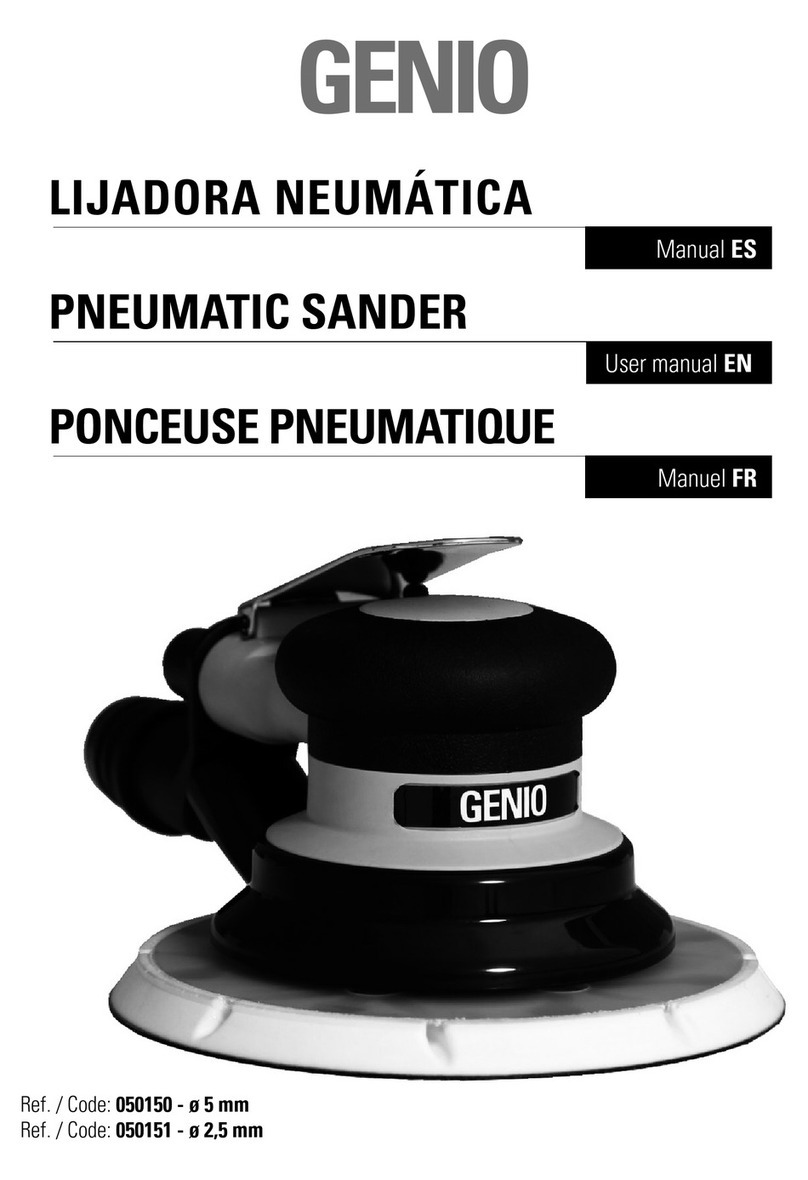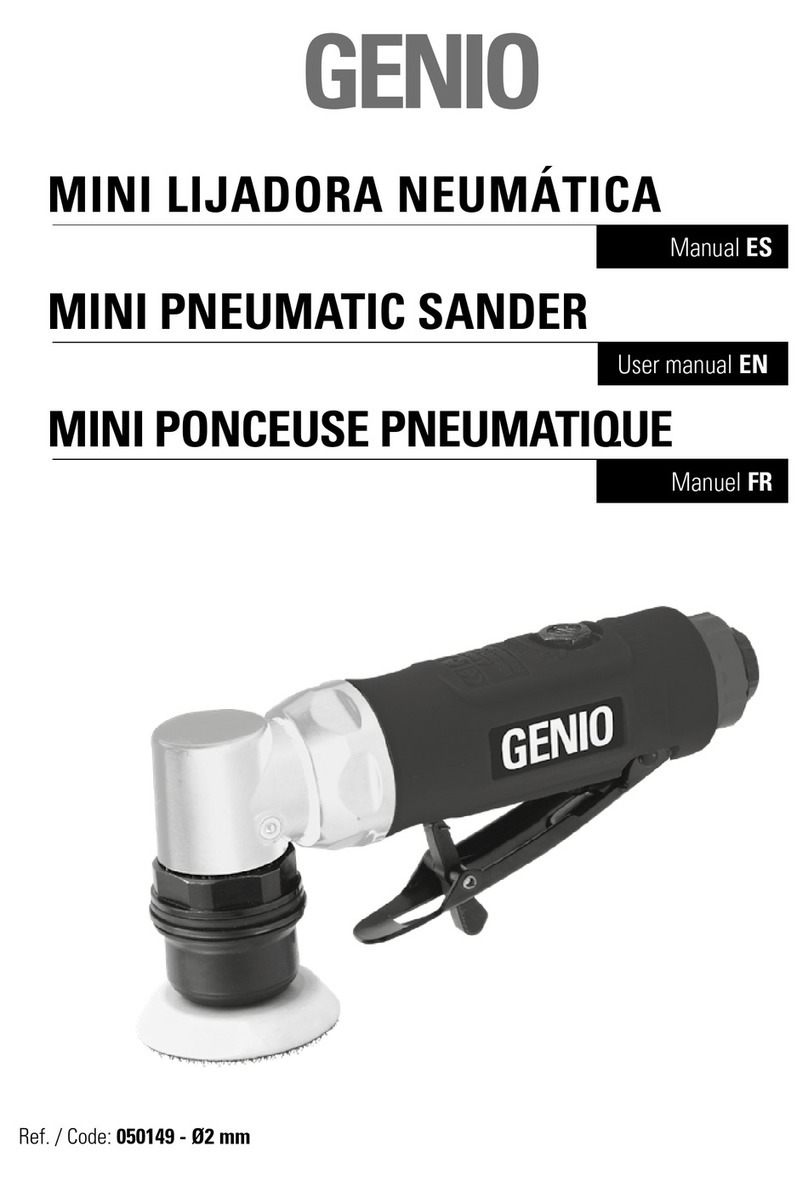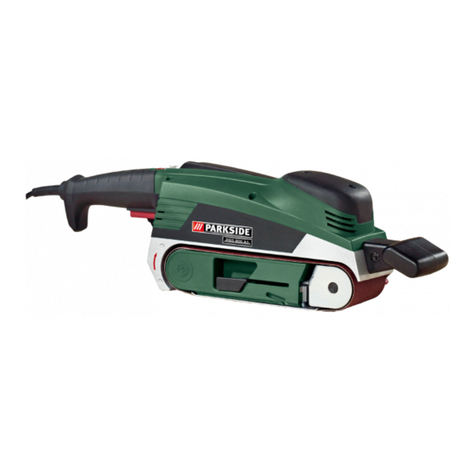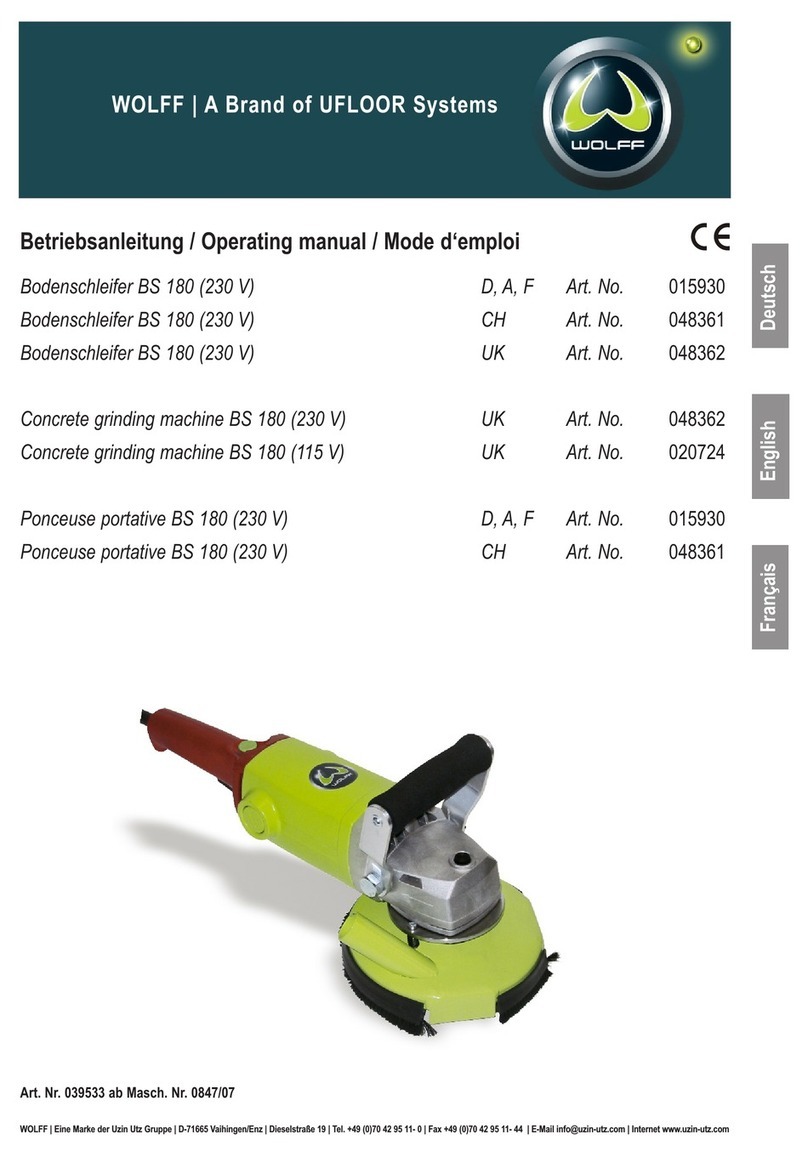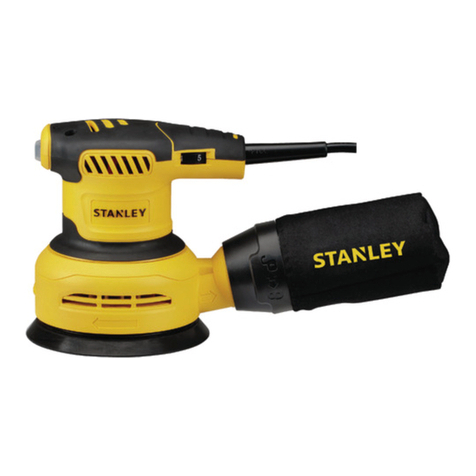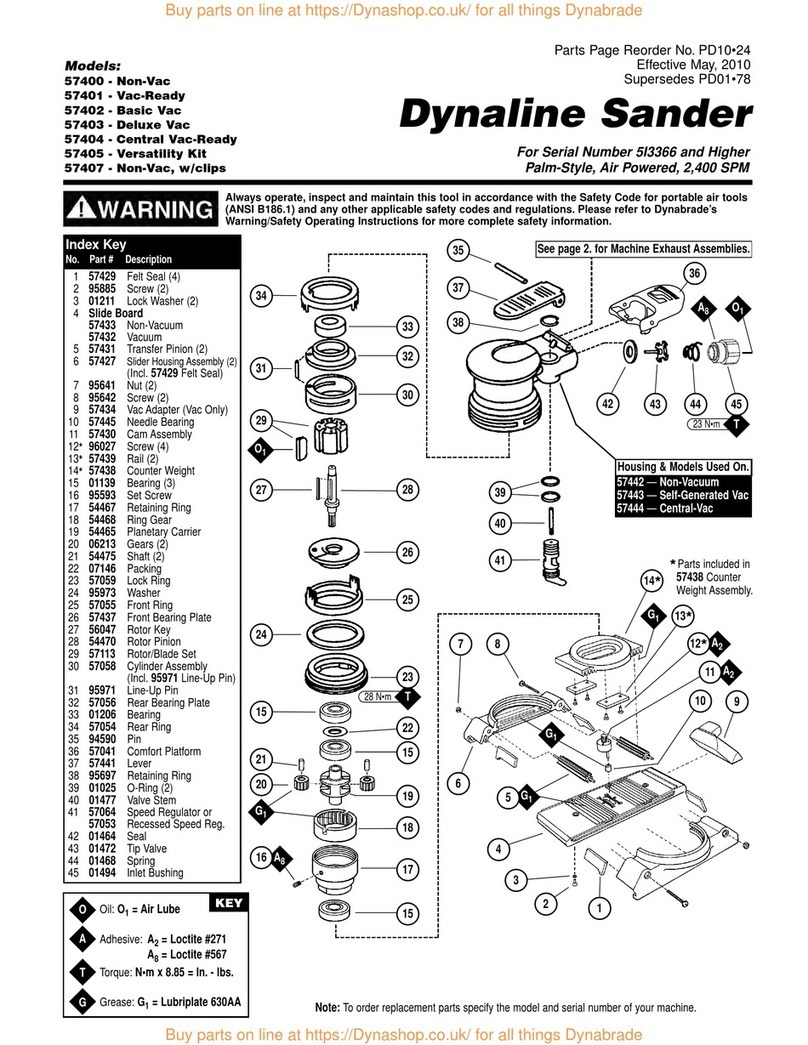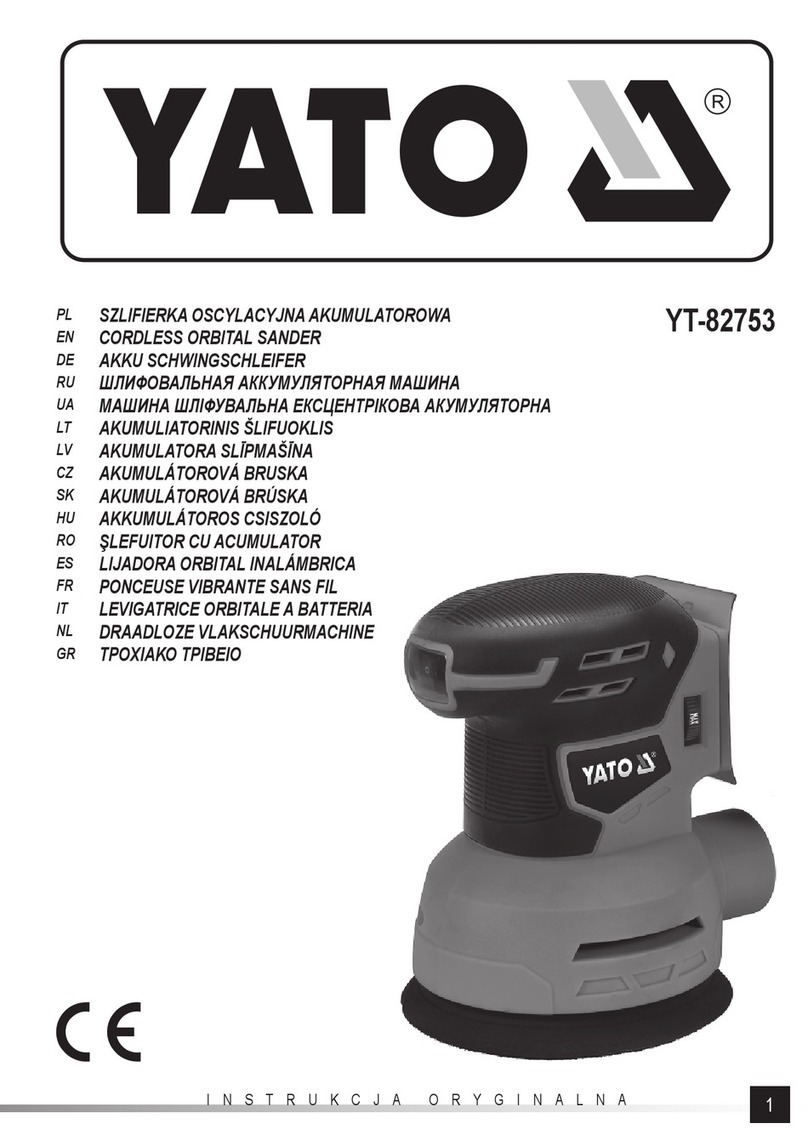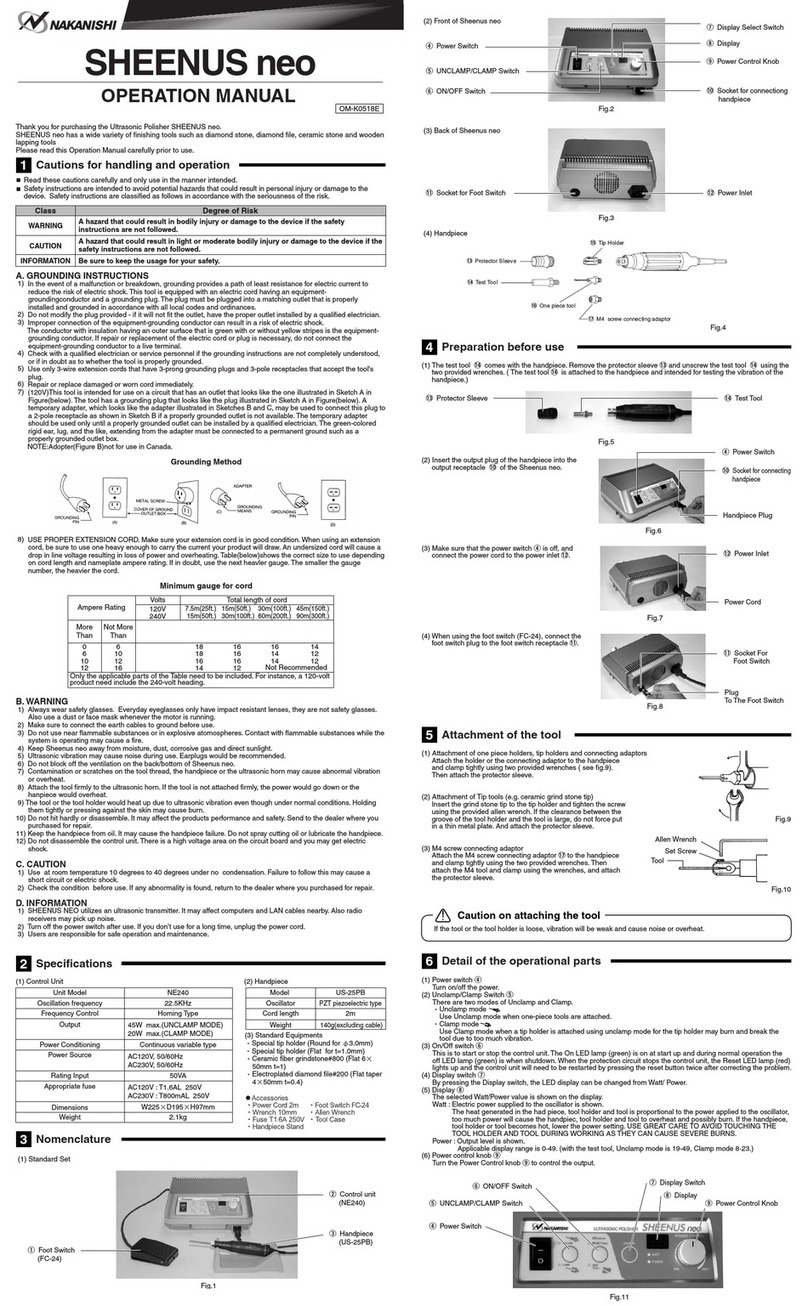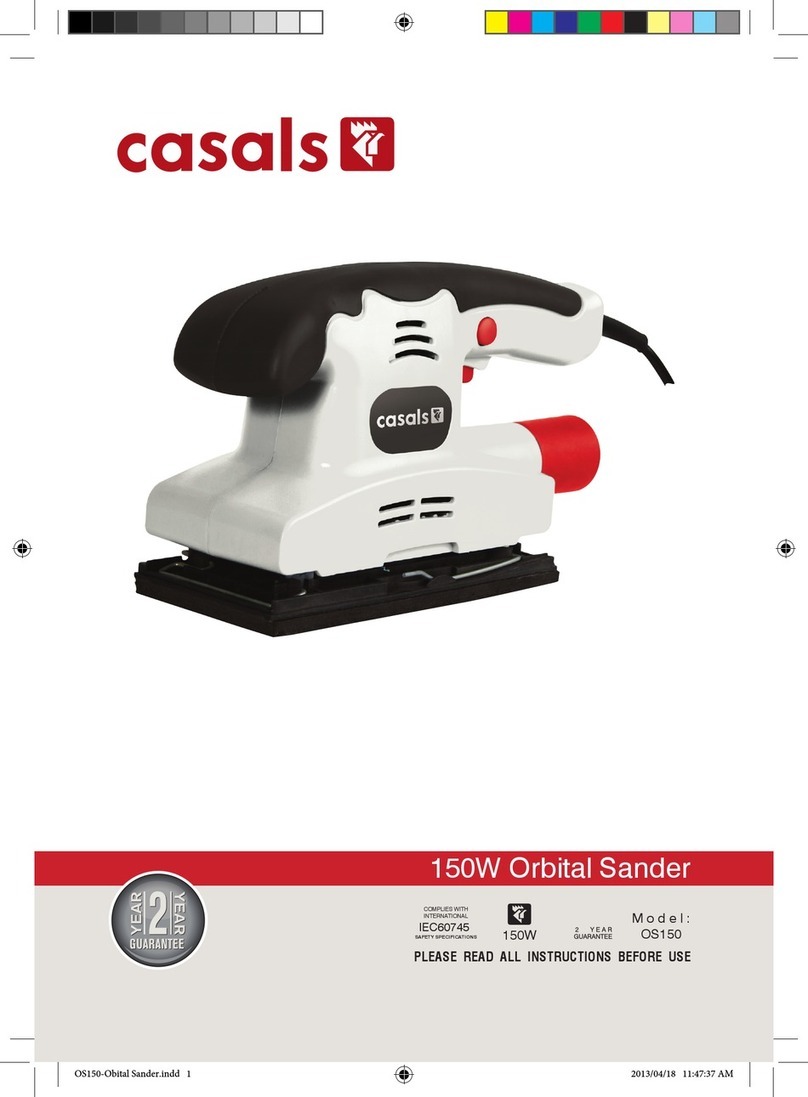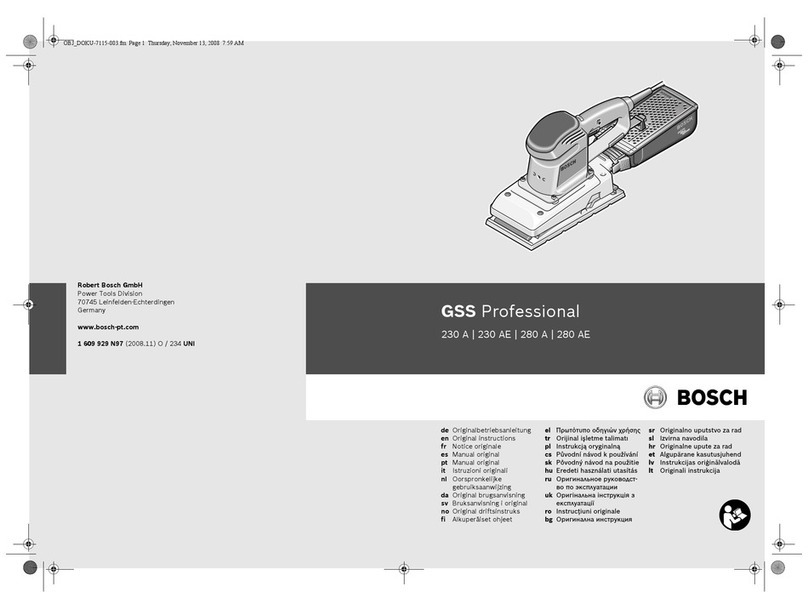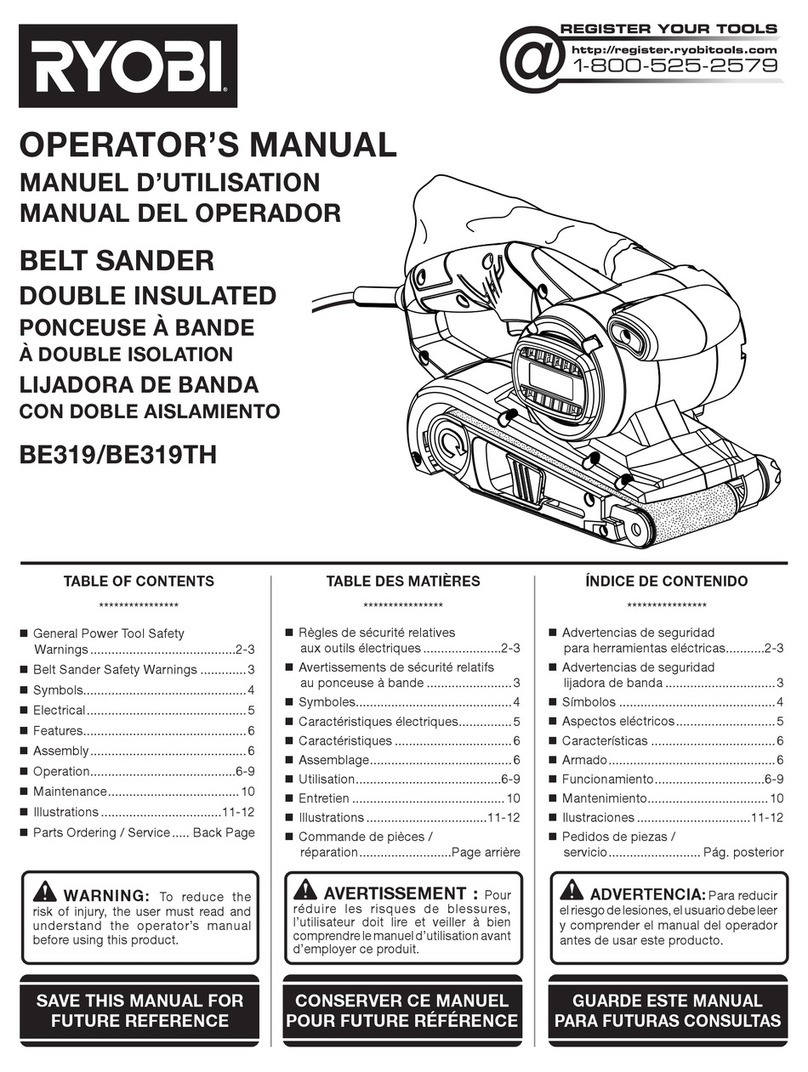Genio 050973 User manual

Ref. / Code: 050973 5 mm
Ref. / Code: 050865 2,5 mm
Manual ES
Lijadora electrónica Orb. Ø5/Ø2,5 mm
220V~240V/150 mm
Electronic random orbital sander Ø5/Ø2,5 mm
220V~240V/150 mm
Manuel FR
Ponceuse orbital electronique Ø5/Ø2,5 mm
220V~240V/150 mm
Manual EN
Manuel FR

2
Manual ES
Contenido
1. Importante información de seguridad y usos. P.2
2. Información de seguridad general para máquinas
electrónicas. P.3
3. Imagen de la máquina y sus partes. P.6
4. Características e instrucciones de uso. P.7-8
5. Resolución de errores y mantenimiento. P.9-10
6. Información adicional. P.2
7. Despiece. P.11
8. Lista de piezas de recambio. P.12
9. Garantía y Servicio. P.12
INSTRUCCIONES DE LA LIJADORA
ELECTRÓNICA ORBITAL
150 mm (6 in)/Órbita: 5 mm / 2,5 mm
2,000 – 10,000 RPM
Input: 220 – 240 VAC 50/60 Hz
1.Información importante
Por favor, lea, comprenda y siga toda la información de
seguridad contenida en estas instrucciones de uso de
esta herramienta. Consérvelas para referencia futura.
Usos
Esta herramienta electrónica está destinada para uso
en lugares industriales y para uso de profesionales
capacitados de acuerdo con las instrucciones de este
manual. Esta herramienta electrónica está diseñada
para ser utilizada con disco y abrasivo adecuado para
el lijado de metales, madera, piedra, plásticos y otros
materiales. Sólo se debe utilizar para este tipo de lijado
y dentro de la capacidad y las calificaciones indicadas. El
uso inadecuado o con otros accesorios podría conllevar
condiciones de funcionamiento peligrosas. No opere
la herramienta en agua o en una zona excesivamente
húmeda. No usar discos con RPM o OPM Max. más bajas
que las RPM máximas de la herramienta.
No usar nunca discos con distinto peso o tamaño de los
recomendados para la máquina.
EXPLICACIÓN DE LOS SÍMBOLOS DE ADVERTENCIA
ATENCIÓN: Indica situación potencialmente peligrosa
que si no se evita puede causar la muerte o graves
daños personales o de la propiedad.
PRECAUCIÓN: Indica situación potencialmente peligrosa
que si no se evita puede causar daños leves de salud o
a las instalaciones.
INFORMACIÓN DE SEGURIDAD DEL APARATO Y EL
EMBALAJE
PRECAUCIÓN: Para manipulación segura, lea el
manual de instrucciones.
Reciclaje: No tirar en la basura doméstica.
Leer el manual de empleo antes de usar.
Usar protección auditiva.
Usar protección ocular.
Usar protección respiratoria.
Mantener la máquina alejada del fuego y
fuentes de calor para reducir el riesgo de
incendio y cortocircuito.
Riesgo eléctrico.
No exponer la máquina a condiciones de
humedad.
Usar guantes de protección resistentes.

3
Leer la fichas de seguridad antes de usar cualquier
material. Contacte con los proveedores de las piezas de
trabajo y los materiales abrasivos si alguna de las fichas
no está disponible.
ATENCIÓN
La exposición al POLVO generada por la pieza de trabajo
y/o materiales abrasivos pueden causar daño pulmonar
y/u otras lesiones. Utilice el dispositivo de extracción de
polvo o la ventilación local como se indica en la ficha de
seguridad.
Use la protección respiratoria, auditiva, ocular y de cuerpo
reglamentaria.
El hecho de no seguir esta advertencia puede provocar
daños graves en los pulmones y/o lesiones físicas
Advertencias
ADVERTENCIAS GENERALES DE SEGURIDAD
PARA MÁQUINAS ELECTRÓNICAS
Lea todas las advertencias de seguridad y todas las
instrucciones. Si no se siguen las advertencias se pueden
ocasionar descargas eléctricas, incendios y/o producirse
lesiones graves.
Guarde todas las advertencias e instrucciones para
referencia futura. El término “herramienta electrónica”
en las advertencias se refiere a la herramienta electrónica
(con cable) operada por la red eléctrica o a la herramienta
electrónica con baterías (inalámbrica).
1. Seguridad del área de trabajo.
a. Mantenga el área de trabajo limpia y bien
iluminada. Las zonas desordenadas y oscuras son
propensas a accidentes.
b. Nooperelosabrasivosenatmósferasexplosivas,
como en presencia de sustancias inflamables,
líquidas, gases o polvo. Los abrasivos crean chispas
que pueden encender el polvo o los humos.
c. Mantenga alejados a los niños y personas
ajenas, no se desplace mientras opera una
herramienta electrónica. Las distracciones pueden
ocasionar una pérdida de control.
2. Seguridad eléctrica.
a. Los enchufes de las herramientas deben
coincidir con la toma de corriente. Nunca
modifique el enchufe de ninguna manera. No utilice
ningún enchufe de adaptador con herramientas
electrónicas con toma de tierra. Utilizar enchufes
sin modificar y las tomas de corriente adecuadas
reducirá el riesgo de descarga eléctrica.
b. Evite el contacto del cuerpo con superficies con
toma de tierra, como tuberías, refrigeradores.
Si su cuerpo tiene conexión a tierra aumenta el
riesgo de descarga eléctrica.
c. No exponga las herramientas electrónicas a
la lluvia ni a condiciones de humedad. El agua
que entra a una herramienta electrónica aumenta el
riesgo de descarga eléctrica.
d. No estire del cordón. Nunca utilice el cable
para transportar, tirar o desconectar la
herramienta. Mantenga el cordón alejado del
calor, aceite, bordes afilados o partes móviles.
Un cable dañado o enredado aumenta el riesgo de
descarga eléctrica.
e. No desenchufar el cable en funcionamiento.
Antes de enchufar o desconectar cualquier
cable, apague el interruptor. Desenchufar en
funcionamiento dañará la herramienta electrónica.
f. Cuando se opere con una herramienta
electrónica al aire libre, utilizar un cable de
extensión adecuado para uso en exteriores. El
uso de un cordón adecuado para uso en exteriores
reduce el riesgo de descarga eléctrica.
g. Si no se puede evitar operar una herramienta
electrónica en un local húmedo, utilice un
circuito de toma de tierra del interruptor (GFCI)
protegido. El uso de un GFCI reduce el riesgo de
descarga eléctrica.
3. Advertencia de seguridad personal.
a. Manténgase alerta, observe lo que está
haciendo y utilice el sentido común cuando
use una herramienta electrónica. No utilice una
herramienta electrónica mientras esté cansado o
bajo la influencia de drogas, alcohol o medicación.
Un momento de distracción mientras se usan
herramientas electrónicas pueden provocar graves
lesiones personales.
b. Utilizar siempre equipo de protección
personal y ocular. El uso de equipos de protección
como mascarilla del polvo, calzado de seguridad
antideslizante, casco duro, o la protección auditiva
reducirá la posibilidad de lesiones personales.
c. Evitar el encendido accidental. Asegúrese de
que el botón esté en posición de “apagado”
antes de conectar a la toma eléctrica o batería,
o antes de coger o mover la herramienta.
Llevar herramientas electrónicas con el dedo en el
interruptor o con el interruptor encendido provoca
accidentes.
Manual ES

4
d. Quite cualquier herramienta de ajuste antes
de encender la lijadora electrónica. Una
herramienta en la parte de rotación de la lijadora
electrónica puede ocasionar lesiones personales.
e. No sobreestime sus capacidades. Mantenga la
posición adecuada y el equilibrio todo el tiempo.
Esto facilita el control de la herramienta electrónica en
situaciones inesperadas.
f. Vestir apropiadamente. No use ropa suelta ni
joyas. Mantenga cabello, ropa y guantes lejos
de las partes móviles. La ropa suelta, la joyería o
el pelo largo se pueden quedar atrapadas en partes
móviles.
g. Si se suministran dispositivos para conectar la
extracción de polvo con las instalaciones de
recogida de polvo, asegúrese que se conectan
y se utilizan correctamente. El uso del extractor
de polvo puede reducir los peligros relacionados con
el polvo.
4. Uso y cuidado de la herramienta electrónica
a. No fuerce la herramienta electrónica. Utilice
la herramienta electrónica correcta para su
aplicación. Usando la herramienta electrónica
adecuada y a la velocidad para la cual fue diseñada,
hará el trabajo mejor y más seguro.
b. No utilice la herramienta electrónica si el
interruptor no la enciende y apaga. Cualquier
herramienta electrónica que no se puede controlar con
el interruptor es peligrosa y debe ser reparada.
c. Desconecte el enchufe de la fuente de
alimentación y/o la batería de la herramienta
electrónica antes de realizar cualquier ajuste,
cambiar accesorios o almacenarla. Tales medidas
de seguridad preventiva reducen el riesgo de arrancar
la herramienta electrónica accidentalmente.
d. Almacene la herramienta electrónica fuera del
alcance de los niños y no deje que sea utilizada
por personas no familiarizadas con la máquina
o las instrucciones. La herramienta electrónica es
peligrosa en manos de usuarios sin formación.
e. Hacer mantenimiento de las herramientas
electrónicas. Comprobar la desalineación o
la unión de piezas móviles, rotura de piezas y
cualquier otra condición que pueda afectar al
uso. Si está dañada, se debe reparar antes de su uso.
Muchos accidentes son causados por herramientas
electrónicas en malas condiciones.
f. Utilice la herramienta electrónica, los
accesorios y las herramientas, etc. de acuerdo
con estas instrucciones, teniendo en cuenta las
condiciones de trabajo y el trabajo a realizar. El
uso de la herramienta para operaciones diferentes de
las previstas podría resultar en situaciones peligrosas.
g. No tire del gatillo. Para evitar destruir la herramienta
electrónica.
5. Servicio
Su herramienta electrónica debe ser reparada
por una persona cualificada usando solamente
las piezas de recambio recomendadas.Esto
garantizará que se mantenga la seguridad de la
herramienta electrónica.
ADVERTENCIAS ADICIONALES DE SEGURIDAD
Sujete la herramienta por las partes diseñadas para
el agarre. Cuando realice un trabajo con la maquina
preste atención para no dañar el cable y evitar así
posibles descargas electricas.
Para reducir los riesgos de daño; usar esta
herramienta con su cable de alimentación, otros tipos de
cable pueden dañar al operario o la máquina.
ATENCIÓN
Para reducir los riesgos asociados con el
impacto del producto abrasivo, el plato o la
ruptura de la herramienta, bordes afilados,
descarga peligrosa, ruptura, vibración y ruido:
• Solo se debe permitir que el personal que esté
debidamente capacitado pueda usar esta
herramienta.
• Si se nota cualquier ruido anormal o vibración
con el uso, pararla inmediatamente y revisar los
componentes desgastados o dañados. Arregle o
reemplace el componente defectuoso. Si persisten
el ruido anormal o vibración, llevar la herramienta a
reparar o cambiarla. Consulte la garantía.
• Antes de usarla, inspeccione el abrasivo y los
accesorios por posibles daños. Si algo está dañado,
reemplace con el nuevo abrasivo o accesorio original.
• Utilice únicamente los accesorios suministrados o
recomendados por el fabricante.
Para reducir los riesgos asociados con
vibración:
• Si se experimenta alguna molestia física en la mano/
muñeca, el trabajo debe detenerse rápidamente y
contactar con un médico. Las lesiones de mano, muñeca
y brazo pueden ser resultado de trabajos repetitivos,
Manual ES

5
movimientos y sobreexposición a la vibración.
Para reducir los riesgos asociados con el ruido
fuerte:
• Siempre use la protección auditiva mientras se trabaja
con esta herramienta. Siga las normas de seguridad
de su empresa o los estándares locales/nacionales
para los requisitos del equipo de protección personal.
Para reducir los riesgos asociados con el
incendio o la explosión:
• No opere la herramienta en atmósferas explosivas,
en presencia de líquidos inflamables, gases o polvo.
Las herramientas electrónicas son capaces de crear
chispas durante su uso, resultando en la ignición del
polvo o humos inflamables.
• Consulte la ficha de seguridad del material sobre el
que se está trabajando para saber sobre el peligro de
incendio o explosión.
Para reducir los riesgos asociados con la
ingestión de polvos nocivos/tóxicos de las
superficies de lijado como superficies pintadas
con plomo, maderas y metales:
• El contacto o inhalación de estos polvos puede poner
en peligro la salud de los operarios y transeúntes.
• Utilice el equipo de protección personal apropiado.
• Utilice protección respiratoria y para la piel
apropiados. La ventilación del lugar de trabajo deberá
ser según indique la ficha de seguridad.
PRECAUCIÓN
Para reducir el riesgo asociado con la
contaminación medioambiental:
• ¡No tire la herramienta electrónica a la basura
doméstica! En conformidad con la Directiva 2002/96/
CE sobre residuos de equipos eléctricos y electrónicos
y transposición en la ley nacional, las herramientas
eléctricas usadas deben recogerse por separado y
reciclarse de forma respetuosa con el medio ambiente.
• La recogida selectiva de los productos y embalajes
usados permite reciclar los materiales. El uso de
materiales reciclados ayuda a prevenir la polución
ambiental y reduce la demanda de materia prima.
• Desechar todo el polvo del proceso de acuerdo con
todas las reglamentaciones aplicables.
Para reducir los riesgos asociados con los
productos abrasivos o piezas que se pueden
desprender al trabajar:
• Tenga cuidado al encajar el producto abrasivo y el
disco, seguir las instrucciones para asegurar que estén
correctamente fijados a la herramienta antes de su uso.
• Nunca haga girar la herramienta de forma casual ni
permita que se encienda accidentalmente.
• Nunca apunte el producto en su dirección o de otra
persona.
• No ajustar en exceso las sujeciones de los accesorios.
SALUD Y SEGURIDAD
Cumple con normativa RoHS
Este producto y los componentes asociados cumplen con
normativa RoHS y no contienen ninguna de las sustancias
que excedan los valores máximos de concentración en la
Directiva UE 2002/95/CE, modificada por la decisión de
la Comisión 2005/618/CE y otras enmiendas emitidas a
partir de la fecha del código marcado en el producto.
A menos que nos indique lo contrario por escrito, esta
información representa nuestro conocimiento basado en
información proporcionada por proveedores.
Compatibilidad con residuos de equipos
eléctricos y electrónicos (WEEE).
• No deseche los aparatos eléctricos como residuos
domésticos no clasificados, utilice un centro de
recogida selectiva municipal. Acudir al gobierno local
para información al respecto.
• Si se desechan aparatos eléctricos en vertederos,
las sustancias peligrosas pueden penetrar el agua
subterránea y entrar en la cadena alimenticia, dañando
su salud y bienestar.
• Al sustituir aparatos antiguos por otros nuevos, el
minorista está legalmente obligado a tomar el antiguo
para su eliminación de forma gratuita.
Manual ES

6
3. IMAGEN DE LA MÁQUINA Y SUS PARTES
Luz indicadora de
operación
Botón encendido/ apagado
RPM+
RPM-
Conexión de
aspiración
Toma de
alimentación
Disco de lijado
Palanca
Cable de alimentación
FIGURA 1. Lijadora
Manual ES

7
NOTA IMPORTANTE: los valores de ruido y vibración
indicados en la tabla son tests de laboratorio, en
conformidad con los códigos y normas indicados y no
suficientemente evaluado para escenarios de exposición.
Los valores reales de exposición y la cantidad de riesgo
o daño experimentado individual es único para cada
situación y depende del entorno, la forma en que en el
que el individuo trabaja, el material específico que se
está trabajando, el diseño del área de trabajo así como la
exposición y la condición física del usuario. No podemos
responsabilizarnos de las consecuencias de usar valores
declarados en lugar de valores de exposición reales para
evaluación de riesgos.
INSTRUCCIONES DE USO
Antes de iniciar el trabajo
1. La herramienta está hecha para uso manual. Siempre
se recomienda que los operarios, estén situados sobre
un suelo estable, en posición segura con una sujeción
firme. Se debe tener en cuenta que la lijadora puede
tener una reacción de torsión.
2. Esta herramienta está diseñada para trabajo de
acabado,nosedebehacerfuerzaconestalijadora
como si fuera una lijadora eléctrica o neumática.
La forma adecuada de usarla es el lijado suave;
se trata más de eficiencia que de lijado duro.
INSTRUCCIONES DE OPERACIÓN
1. Conecte el cable de alimentación de AC de la lijadora a
la fuente de salida (220 ~ 240VAC).
2. Presione el botón de on/off para encender la lijadora.
El indicador LED muestra un color “verde intenso” si
la lijadora está encendida.
3. Ajuste la velocidad pulsando los botones “+” o “ ” .
Pulse “+” para subir a una velocidad mayor, “-” es bajar
la velocidad. El indicador LED muestra el color “rojo
intenso”. La luz LED no parpadeará cuando el motor
alcance la velocidad máxima o mínima.
4. Presione la palanca para arrancar la herramienta.
Suelte la palanca para detener la herramienta.
5. Pulse el botón de encendido/apagado “ ” para
desconectar la lijadora.
Estado de suspensión
El Sistema de seguridad reduce las posibilidades de
errores. Si la máquina está inactiva más de 3 min., el
sistema de seguridad la pondrá en estado de suspensión.
En este estado, el indicador LED estará sin luz. La
lijadora tendrá que ser reiniciada.
Indicación de error
Si el indicador LED parpadea en verde y rojo
alternativamente, es por un error. Revisar en el apartado
de “Resolución de problemas” para resolverlo.
FUNCIÓN DE VELOCIDAD MÁXIMA
Esta lijadora orbital electrónica tiene nueve velocidades
preestablecidas (2000-10000 RPM.).
La lijadora no está configurada desde fabrica para
empezar con la máxima velocidad. Cuando se enciende
la lijadora con la fuente de alimentación en “on”
a velocidad máxima se puede cambiar en cualquier
momento mientras la lijadora está en marcha o en modo
“Run”, siempre y cuando la fuente de alimentación esté
activada “on”.
Cualquier ajuste para velocidad máxima se guardará
Especificaciones
Tipo de lijadora Aspirado central
Ø órbita (mm) 5(3/16) / 2,5 (3/32)
Ø plato (mm) 150(6)
R.P.M. 2.000 – 10.000
Agujeros 15
Potencia máx. 350W Max.
Voltaje de red 220~240VAC
Medidas 251*150*94 (mm)
Peso (kg) 0.9
Conexión manguera Ø26.5mm
Manual ES
4. CARACTERÍSTICAS E INSTRUCCIONES DE USO

8
mientras la fuente de alimentación esté encendida.
Cuando la fuente de alimentación está apagada, se
mantendrá el último ajuste utilizado cuando volvamos a
activar la fuente de alimentación.
VELOCIDAD MÁXIMA Y CONTROL DE VELOCIDAD
INTERMEDIA
1. La velocidad máxima se ajusta pulsando el botón “+”
o “—” en la parte posterior de la lijadora. Mientras la
lijadora está en modo “Run”, cada pulsación subirá o
bajará la velocidad al siguiente ajuste.
2. En el modo predeterminado la velocidad se puede
ajustar linealmente ajustando la posición de la palanca.
FUNCIÓN DE ARRANQUE SUAVE
La lijadora tiene la función de arranque suave que
previene el rallado de la superficie de trabajo.
SISTEMADEPROTECCIÓNCONTRASOBRECARGA
La lijadora está equipada con sistema de sobrecarga.
Durante los periodos con demasiada sobrecarga del
usuario, el LED de la lijadora parpadeará en color “rojo”
y ralentizará el motor como advertencia al usuario y para
mantener la máxima eficiencia de giro en condiciones
de sobrecarga.
La carga continua no debe ser superior a 3 kg
aproximadamente.
Si se continua con la sobrecarga, el indicador LED
parpadeará “rojo y verde” alternativamente y la lijadora
se parará.
Para reiniciar la lijadora inmediatamente, liberar la
palanca y presione de nuevo para continuar con el lijado.
La sobrecarga repetida resultará en paradas frecuentes
del motor y un aumento de temperatura de la
herramienta.
Sistema de protección para el
sobrecalentamiento
La lijadora tiene la capacidad de controlar la temperatura
de los sistemas electrónicos internos y puede apagar
la herramienta cuando la temperatura alcance niveles
dañinos.
Durante los periodos que resulten en una temperatura
interna alta, la lijadora se apagará si la temperatura
alcanza un nivel perjudicial, la lijadora no podrá ser
reiniciada hasta que el nivel de temperatura interna se
enfríe a un nivel seguro para los sistemas electrónicos.
El tiempo de enfriamiento depende de condiciones
locales. Se recomienda un tiempo inicial de espera de 5
minutos. Los sobrecalentamientos repetidos resultaran
en un tiempo de enfriamiento más largo.
FIJACIÓN DEL DISCO DE LIJADO
Los discos de lijado están especialmente diseñados para
acoplarse a la lijadora orbital electrónica.
1. Asegure el perno con la llave provista con la
herramienta y atornille el disco. Atornillar a mano para
fijarlo. No apretarlo excesivamente.
2. Para extraer el disco, inserte la llave entre el disco
y la cubierta. Asegure el perno con la llave plana y
desenrosque el disco.
LIMPIEZA
1. Soplar periódicamente todas las entradas de aire y el
área por encima del disco y debajo de la cubierta con
aire comprimido. Todas las piezas de plástico deben
limpiarse sólo con un paño húmedo. Nunca utilizar
disolventes.
2. Usar gafas de seguridad mientras usa el aire
comprimido.
Manual ES

9
SOLUCIONES HABITUALES
Anomalía Solución
Ni destello ni
funcionamiento al encender Revisar que esté correctamente enchufada o si hay anomalía de montaje.
Vibración excesiva Revisar que el disco sea del tipo adecuado o si necesita un cambio.
Ruido anómalo en
funcionamiento
Dejar de usar la máquina. Revisar si hay piezas dañadas o contactar con servicio técnico
certificado.
Anomalía en la palanca Error en programa de ruta. Hacer reset del programa siguiendo los pasos necesarios.
Manual ES
Señal anomalía Anomalía Solución
Un destello largo
y uno corto
Funcionamiento
anormal motor Fallo motor. Contactar con servicio técnico certificado.
Un destello largo
y dos cortos
Anomalía eléctrica del
motor Fallo motor. Contactar con servicio técnico certificado.
Un destello largo
y tres cortos
Anomalía de
temperatura Apagar la máquina un tiempo. Reiniciar cuando se enfríe.
Un destello largo
y cuatro cortos
Anomalía de fase del
motor
Si persiste el error tras reiniciar, contactar con servicio técnico
certificado. Fallo de motor.
Un destello largo
y cinco cortos
Anomalía de bajo
voltaje Revisar que el voltaje no sea demasiado bajo
Un destello largo
y seis cortos
Anomalía de alto
voltaje Revisar que el voltaje no sea demasiado alto
Un destello largo
y siete cortos
Anomalía de placa
base Fallo de placa base. Contactar con servicio técnico certificado.
Un destello largo
y ocho cortos
Anomalía de
temperatura del motor
Apagar la máquina un tiempo. Si el error persiste al arrancar, contactar
con servicio técnico certificado.
5. RESOLUCIÓN DE ERRORES Y MANTENIMIENTO
Repare su herramienta electrónica con una persona cualificada y utilice solamente piezas de recambio
del fabricante original. Esto garantizará que se mantenga la seguridad de la herramienta electrónica.
6. RESOLUCIÓN DE PROBLEMAS PARA SEÑALES DE ANOMALÍA
Es una anomalía cuando el indicador LED muestra el color “rojo y verde” parpadeando.
Para saber acerca de la anomalía, por favor siga las siguientes instrucciones:
Pulse el botón “— “ y mantener durante cinco segundos, hasta que indicador LED muestra el color “rojo”

10
PROCEDIMIENTO DE RESTABLECIMIENTO DE LA
PALANCA
El procedimiento de reinicio será necesario cuando la
lijadora opere anormalmente o tras mantenimiento.
1. Desconecte.
2. Pulse y mantenga pulsado el botón “+” . A continuación,
conecte el cable de alimentación. (Figura 1). Pulse el
botón “—” 5 veces (Figura 2) y la herramienta ahora
entrará en el modo de reinicio.
3. Asegúrese de soltar la palanca (Figura 3) y el botón
“+”.Espere a que el LED parpadee en color rojo, dos
veces.
4. Presione firmemente la palanca de velocidad
(Figura 5) y espere a que el LED parpadee
“rojo” rápidamente (Figura 6), suelte
inmediatamente la palanca de velocidad (Figura
7). Espere a que la luz roja se apague (Figura
8), el proceso de restablecimiento ha finalizado.
Figura 1
Figura 2
Figura 3
Figura 4
Figura 5
Figura 6
Figura 7
Figura 8
6. INFORMACIÓN ADICIONAL
Adaptador
Manual ES

11
7. DESPIECE
Modelo. Lijadora
12-1
12-2
12-3
12A
12-4
12-5
18
17
21
20
16 15 14 13
12
11
10
8
7
6
5
4
3
9
19
2
1
Manual ES

12
No. Descripción Uds.
1 Palanca 1
2 M2.6*12 tornillo palanca 1
3 Botón de POM 1
4 Cubierta de placa 1
5 2.6*6 tornillo 4
6 220~240V Control velocidad 1
7 Placa de EVA 2
8VR Pot. Set 1
9 Palanca de ajuste 1
10 Muelle de ajuste 1
11 Carcasa 1
12 220~240V 6”-3/16/ motor 1
12A 5”-6”- juego de ejes 1
12-1 Rodamiento de bolas de dos hileras 1
12-2 Arandela de fibra 1
12-3 Arandela metálica 1
12-4 5”-6” Perno 1
12-5 Ø28 Clip 1
13 Cobertura para polvo A 1
14 Cobertura para polvo B 1
15 2.6*8/ tornillo PCB 2
16 Ø26.5 mm juego adaptadores manguera 1
17 2.6*6 Tornillos PCB 2
18 1/8*6 Tornillo 2
19 6”/ Plato 1
20 Cable alimentación 1
21 Llave hexagonal para disco 1
9. GARANTÍA Y SERVICIO
• La garantía de esta máquina es de 1 año a partir
de la fecha de compra y es válida para defectos de
fabricación y materiales en condiciones normales
de uso.
• Para que la cobertura de garantía sea válida,
el usuario es responsable de determinar si la
herramienta es apta para un uso particular y
debe operar la herramienta de acuerdo con todas
las instrucciones, indicaciones de seguridad y
otros procedimientos indicados en el manual de
instrucciones. No tendremos obligación de reparar
o reemplazar cualquier herramienta o pieza que
falle debido al desgaste normal, el mantenimiento
o limpieza inadecuados, falta de lubricación,
entorno de uso inadecuado, error o mal uso del
operador o mal uso, alteración o modificación o
debido a cualquier causa accidental.
• Para validar la garantía de su herramienta,
se puede hacer mediante nuestra web www.
bossauto.com en el banner de la home o por medio
de su distribuidor. En el caso de no realizar el
registro de la garantía, esta no será válida.
Manual ES
8. Lista de piezas de recambio.

13
Manual EN
Contents
1. Important Safety information and product range
application. P.13
2. General power tool safety warning. P.14-16
3. Tool appearance and names of each parts. P.17
4. Product specification and operating instructions.
P.18-P.19
5. Convenient error resolution and maintain. P.20-21
6. Accessory information.P.21
7. Exploded View.P.22
8. Spare parts list.P.23
9. Warranty and term of service. P.23
DIRECT ELECTRIC RANDOM ORBITAL
SANDER INSTRUCTION
150 mm (6 in)/Orbit: 5 mm / 2,5 mm
2,000 – 10,000 RPM / Input: 220 – 240 VAC 50/60 Hz
1. Important Safety Information
Please read, understand and follow all safety information
contained in these instructions prior to the use of this
tool. Retain these instructions for future reference.
Intended Use
This electric tool is intended for use in industrial
locations, and used only by skilled, trained professionals
in accordance with the instructions in this manual. This
electric tool is designed to be used with a disc pad and
appropriate abrasive for sanding metals, wood, stone,
plastics and other materials. It should only be used for
such sanding applications and within marked capacity
and ratings. Only accessories specifically recommended
by us should be used with this tool. Use in any other
manner or with other accessories could lead to unsafe
operating conditions.Do not operate tool in water or in
an excessively wet application. Do not use disc pads that
have a Max RPM or Max OPM less than the tool Max
RPM or Max OPM rating. Never use disc pads that have
a weight and/or size different from what the tool was
specifically designed for.
EXPLANATION OF SIGNAL WORD CONSEQUENCES
WARNING: Indicates a potentially hazardous situation
which, if not avoided, may result in death or serious
injury and/or property damage.
CAUTION: Indicates a potentially hazardous situation
which, if not avoided, may result in minor or moderate
injury and/or property damage.
SUMMARY OF DEVICE AND CARTON LABELS
CONTAINING SAFETY INFORMATION
ATTENTION: For a correct use, read the user’s
manual firstly.
Recycling: Can not be disposed with household
waste.
Read the user manual before using.
Wear hearing protection.
Wear protective eyewear.
Use respiratory protection.
Please keep the machine away from fire and
heat to reduce the risk of fire and wire short.
Electrical risk.
Do not expose power tool to wet conditions.
Use resistant gloves.

14
Read the Material Data Sheets (MSDS) before using
any materials. Contact the suppliers of the workpiece
materials and abrasive materials for copies of the MSDS
if one is not readily available.
ATENCION
Exposure to DUST generated from workpiece and/ or
abrasive materials can result in lung damage and/ or
other physical injury.Use dust capture or local exhaust
as stated in the MSDS. Wear government-approved
respiratory Protection and eye protection and hearing
protection and skin protection. Failure to follow this
warning can result in serious lung damage and/ or
physical injury.
WARNING
GENERAL POWER TOOL SAFETY WARNINGS
Read all safety warnings and all instructions. Failure
to follow the warnings and instructions may result
in electric shock, fire, and/or other serious injury.
Save all warnings and instructions for future
reference. The term “power tool” in the warnings
refers to your mains-operated (corded) power tool or
battery operated (cordless) power tool.
1. Work Area Safety
a. Power tools plugs must match the outlet.
Never modify the plug in any way. Do not use
any adapter plugs with earthed (grounded)
power tools. Unmodified plugs and matching
outlets will reduce risk of electric shock.
b. Avoid body contact with earthed or grounded
surfaces such as pipes, radiators, ranges
and refrigerators. There is an increased risk of
electric shock if your body is earthed or grounded.
Do not expose power tools to rain or wet
conditions. Water entering a power tool will
increase the risk of electric shock.
c. Do not abuse the cord. Never use the cord
for carrying, pulling or unplugging the power
tool. Keep cord away from heat, oil, sharp
edges or moving parts. Damaged or entangled
cords increase the risk of electric shock.
d. Do not hotplug the cord. Before plugging
or unplugging any cord, turn off the switch.
Hotplugging will damage the power tool.
e. When operating a power tool outdoors, use
an extension cord suitable for outdoor use.
Use of a cord suitable for outdoor use reduces the
risk of electric shock.
f. If operating a power tool in a damp location
is unavoidable, use a ground fault circuit
interrupter (GFCI) protected supply. Use of a
GFCI reduces the risk of electric shock.
2. Personal Safety
a. Stay alert, watch what you are doing and
use common sense when operating a power
tool. Do not use a power tool while you are
tired or under the influence of drugs, alcohol
or medication. A moment of inattention while
operating power tools may result in serious
personal injury.
b. Use personal protective equipment. Always
wear eye protection. Protective equipment such
as dust mask, non-skid safety shoes, hard hat, or
hearing protection used for appropriate conditions
will reduce personal injuries.
c. Prevent unintentional starting. Ensure
the switch is in the off-position before
connecting to power source and/or battery
pack, picking up or carrying the tool. Carrying
power tools with your finger on the switch or
energizing power tools that have the switch on
invites accidents.
d. Remove any adjusting key or wrench before
turning the power tool on. A wrench or a key
left attached to a rotating part of the power tool
may result in personal injury.
e. Do not overreach. Keep proper footing and
balance at all times. This enables better control
of the power tool in unexpected situations.
f. Dress properly. Do not wear loose clothing or
jewelry. Keep your hair, clothing and gloves
away from moving parts. Loose clothes, jewelry
or long hair can be caught in moving parts.
g. If devices are provided for the
connection of dust extraction and
collection facilities, ensure these are
connected and properly used. Use of dust
collection can reduce dust-related hazards.
4. Power Tool Use and Care
a. Do not force the power tool. Use the correct
power tool for your application. The correct
power tool will do the job better and safer at the
rate for which it was designed.
b. Do not use the power tool if the switch does
not turn it on and off. Any power tool that cannot
be controlled with the switch is dangerous and
must be repaired.
Manual EN

15
c. Disconnect the plug from the power source
and/or the battery pack form the power tool
before making any adjustments, changing
accessories, or storing power tools. Such
preventive safety measures reduce the risk of
starting the power tool accidentally.
d. Store all power tools out of reach of children
and do not allow persons unfamiliar with the
power tool or these instructions to operate
the power tool. Power tools are dangerous in the
hands of untrained users.
e. Maintainpower tools. Check formisalignment
or binding of moving parts, breakage of parts
and any other condition that may affect the
power tool’s operation. If damaged, have
the power tool repaired before use. Many
accidents are caused by poorly maintained power
tools.
f. Use the power tool, accessories and tool bits,
etc. in accordance with these instructions,
taking into account the working conditions
and the work to be performed. Use of the power
tool for operations different from those intended
could result in a hazardous situation.
g. Do not pull the trigger. In order to avoid
destroying the power tool.
5. Service
Have your power tool serviced by a qualified
repair person using only identical replacement
parts. This will ensure that the safety of the power
tool is maintained.
ADDITIONAL SAFETY WARNINGS
Hold power tools by insulated gripping surfaces
when performing an operation where the cutting
tool may contact hidden wiring or its own cord.
Contact with a “live” wire will make exposed metal
parts of the tool “live” and shock the operator.
To reduce the risk of injury. Operate this Electric
power tool with our Power Cord. Other types of power
Cord may cause personal injury or damage.
WARNING
To reduce the risks associated with impact from
abrasive product, disc pad, or tool breakup, sharp edges,
hazardous downforce, rupture, vibration and noise:
• Only personnel who are properly trained should be
allowed to service this tool.
• If you notice any abnormal noise or vibration when
operating the tool, immediately discontinue its
use and inspect for worn or damaged components.
Correct or replace the suspect component. If
abnormal noise or vibration still exists, return
the tool to us for repair or replacement. Refer to
warranty instructions.
• Prior to use, inspect abrasive product and accessories
for possible damage. If damaged, replace with new
abrasive product and accessories available from us.
• Only use accessories supplied or recommended by us.
To reduce the risks associated with vibration:
• If any physical hand/wrist discomfort is experienced,
work should be stopped promptly to seek medical
attention. Hand, wrist and arm injury may result
from repetitive work, motion and overexposure to
vibration.
To reduce the risks associated with loud noise:
• Always wear hearing protection while operating
this tool. Follow your employer’s safety policy or
local national standards for personal protective
equipment requirements.
To reduce the risks associated with fire or
explosion:
• Do not operate the tool in explosive atmospheres,
such as in the presence of flammable liquids, gases,
or dust. The abrasives are able to create sparks
when working material, resulting in the ignition of
the flammable dust or fumes.
• Refer to MSDS of material being worked as to
potential for creating fire or explosion hazard.
To reduce the risks associated with ingestion of
harmful / toxic dusts from sanding surfaces such
as lead painted surfaces, woods and metals:
• Contact with or inhalation of these dusts can
endanger the health of operator and bystanders. Use
appropriate personal protective equipment.
• Use appropriate respiratory and skin protection, or
local exhaust as stated in the MSDS of the material
being worked on.
Manual EN

16
CAUTION
To reduce the risk associated with
environmental contamination:
• Do not throw electric power tools into the household
waste! In accordance with the European Directive
2002/96/CE on Waste Electrical and Electronic
Equipment and transposition into national law, used
electric power tools must be collected separately
and recycled in an environmentally friendly manner.
• Separate collection of used products and packaging
allows materials to be recycled. Use of recycled
materials helps prevent environmental pollution and
reduces the demand for raw materials.
• Dispose of all the process dust in accordance with
all applicable regulations.
To reduce the risks associated with fly off of
abrasive product or parts:
• Use care in attaching abrasive product and disc pad;
following the instructions to ensure that they are
securely attached to the tool before use.
• Never free spin the tool or otherwise allow it to be
started unintentionally.
• Never point this product in the direction of yourself
or another person, or start tool unintentionally.
• Never over-tighten accessory fasteners.
HEALTH AND SAFETY INFORMATION
RoHS Compliant
This product and the associated component parts
are “RoHs Compliant” and do not contain any of the
substances in excess of the maximum concentration
values in EU Directive 2002/95/EC, as amended
by Commission Decision 2005/618/EC and other
amendments issued as of the date code marked on the
product.
Unless otherwise stated by us in writing, this
information represents our knowledge and belief based
on information provided by third party suppliers to us.
Waste Electrical & Electronic Equipment
(WEEE) Compliant.
• Do not dispose of electrical appliances as unsorted
municipal waste, use separate collection facilities.
• Contact your local government for information
regarding the collection systems available
• If electrical appliances are disposed of in landfills
or dumps, hazardous substances can leak into the
groundwater and get into the food chain, damaging
your health and well-being.
• When replacing old appliances with new ones, the
retailer is legally obligated to take back your old
appliance for disposal at least for free of charge.
Manual EN

17
3. TOOL APPEARANCE AND NAMES OF EACH PARTS
Operation
Indication lamp
ON/OFF
RPM+
RPM-
Hose Connection
DC Socket
Backing Pad
Lever
Power Cord
Adapter
FIGURE 1. Sander
Manual EN

18
IMPORTANT NOTE: The noise and vibration values
stated in the table are from laboratory testing in
conformity with stated codes and standards and are
not sufficient risk evaluation for all exposure scenarios.
The actual exposure values and amount of risk or harm
experienced to an individual is unique to each situation
and depends upon the surrounding environment, the way
in which the individual works, the particular material
being worked, work station design, as well as upon the
exposure time and the physical condition of the user.
We cannot be held responsible for the consequences of
using declared values instead of actual exposure values
for any individual risk assessment.
OPERATING INSTRUCTIONS
PRIOR TO THE OPERATION
1. The tool is intended to be operated as a hand held
tool. It is always recommended that while using the
tool, operators stand on a solid floor, in a secure
position with a firm grip and footing. Be aware that
the sander can develop a torque reaction.
2. This tool is designed for fine finishing task, do not
forcesanderheavilylikeconventionalelectricsanders
or air sanders. Slightly sanding is the proper way in
use; it can be more efficiency than heavily sanding.
OPERATING INSTRUCTIONS
1. Plug-in the sander’s AC power cord to the power
source (220~240VAC output).
2. Press the power ON/OFF button “ ”, on the button
plate to switch on the sander. The LED indicator
shows “ Solid green ” color after sander being
switched on.
3. Adjust the speed by pressing “+”or “— ” buttons
on the button plate. Press “ + ” is to raise up to higher
speed setting, “— ”is to lower the speed setting.
The LED indicator shows “ flash red ” color . The LED
light won’t flash when the motor reach the maximum
& the minimum speed.
4. Press the lever to start the tool. Release the Lever to
stop the tool.
5. Press the power ON/OFF button “ ”, on the button
plate to switch off the sander.
HIBERNATION
The security system can reduce the possibilities to
malfunction. If the tool standby over 3 mins, the security
system will execute immediately into Hibernation/ Off.
In the Hibernation mode, there won’t be any lights on
the LED indicator. The sander needs to be restart.
ABNORMAL INDICATION
Malfunction happens when the LED flashes“red and
green” alternately. Please refer to the trouble shooting
instruction to solve the abnormities.
MAXIMUM SPEED FUNCTION
This Electric Random Orbital Sander has nine preset
Maximum Speeds (2,000-10,000 RPM.) The original
starting speed seting is not the maximum speed when
the tool was shipped out from the manufacturer.When
the Sander is started after the Power Supply is turned
“ON”. The Maximum Speed can be changed at any time
while the Sander is running or when it is stopped and
Specification
Sander Type Central Vacuum
Ø Orbit (mm) 5(3/16) / 2,5 (3/32)
Ø Pad Size (mm) 150(6)
Free Speed R.P.M. 2,000-10,000
Motor Hp (W) 350W Max.
Mains Voltage 220~240VAC
Measurement 251*150*94 (mm)
Weight (Kgs) 0.9
Hose Connection Ø26.5mm
Manual EN
4. PRODUCT SPECIFICATION AND OPERATING INSTRUCTIONS

19
still in “Run” Mode, as long as the Power Supply is
turned “ON”. Any setting for the Maximum Speed will
be stored while the Power Supply is turned “ON”.When
the Power Supply is turned “OFF”, the setting will be
kept at the last time you used when the Power Supply
is turned “ON” again.
MAXIMUM SPEED AND INTERMEDIATE SPEED
CONTROL
1. Maximum Speed is adjusted by pressing the “ + ” or
“—” buttons on the back of the Sander. While the
Sander is in “Run” Mode, each touch will raise or
lower the speed to the next setting.
2. In the default mode the speed can be adjusted
linearly by adjusting the position of the lever.
SOFT START FUNCTION
The sander has the soft start function that prevents
gouging of the work surface.
OVERLOAD PROTECTION SYSTEMS
The Sander is equipped with Downforce Overload
System. During periods of overly high user downforce,
the sander LED will flash“red” color and cause the
motor to slow slightly as a warning to the user, and to
maintain the most efficiency spinning power under the
condition of overload. Continuous downforce should be
no greater than approximately 3 Kg.
If the user continues with overly high downforce
greater than 3 Kg, the sander will change
the LED flashes“red and green” alternately and stop.
To restart the sander immediately, released the lever
and pressed down again and continue sanding.
Repeated overloading will result in frequent motor
stops and increased tool temperature.
Temperature Overheat System
The Sander has the ability to monitor temperature
of the internal electronic systems, and can shut the
tool down when temperature reach damaging levels.
During periods that result in high internal temperature,
the Sander will shut down if the temperature reaches
a damaging level. The Sander will not be able to
be restarted until the internal temperature cools
to a level safe for the electronic systems. Cooling
time depends on local conditions. An initial waiting
period of 5 minutes is recommended. Repeated
overheating will result in longer cool down times.
ATTACHING DISC PADS
Disc Pads are specially designed to mate to the Electric
Random Orbital Sander.
1. Secure the Spindle with the flat wrench provided
with the tool, and screw the Disc pad on. Tighten to
firm hand-tightness. Do not over tighten.
2. To remove the Disc Pad, insert the flat wrench
between the Disc Pad and shroud. Secure the
Spindle with the flat wrench and unscrew the Disc
pad.
CLEANING
1. Periodically blow out all air passages and area above
Disk Pad and under shroud with dry compressed air.
All plastic parts should be cleaned with a soft damp
cloth. NEVER use solvents to clean plastic parts.
2. Wear safety glasses while using compressed air.
Manual EN

20
Abnormal signal Abnormity Solution
One long & one short flash Motor operating abnormally Motor failure. Please contact a qualified
repair person.
One long & two short flash Motor electric current abnormity Motor failure. Please contact a qualified
repair person.
One long & three short flash PCB temperature abnormity Please turn off the tool for a while. Restart the
tool after cooling.
One long & four short flash Motor phase failure
If it is still failure after restart, please contact
a qualified repair person. Motor failure.
Please contact a qualified repair person.
One long & five short flash Input low voltage abnormality Please check if the voltage is too low.
One long & six short flash Input high voltage abnormality Please check if the voltage is too high.
One long & seven short flash Programs of circuit board
abnormality
Circuit board failure. Please contact a
qualified repair person.
One long & eight short flash Motor temperature abnormality
Please turn off the tool for a while. Restart
the tool atfer cooling. If it is still failure after
restart, please contact a qualified repair
person.
NORMAL TROUBLESHOOTING
Abnormity Solution
No flash and operation after start Please check if the plug is inserted successfully or voltage
abnormality.
Excessive vibration Please check if the pad is out of shape and need to be
changed.
Abnormal noise while working Please stop using the tool. Please check if the spare parts
are damaged, or contact a qualified repair person.
Lever abnormality Seng route program failure. Please reset the program by
following reset procedure.
Manual EN
Keep your power tool revised by a qualified repair
person and use only replacement
parts of original manufacturer.
This will ensure that the safety of the power tool
is maintained.
5. CONVENIENT ERROR RESOLUTION AND MAINTENANCE
ABNORMAL SIGNAL TROUBLESHOOTING
It is an abnormity when the LED indicator shows flash “red
and green” color. To acknowledge about the abnormity,
please follow the instructions below: Press —button hold
for five seconds, the LED indicator shows flash “red” color.
This manual suits for next models
1
Table of contents
Languages:
Other Genio Sander manuals
